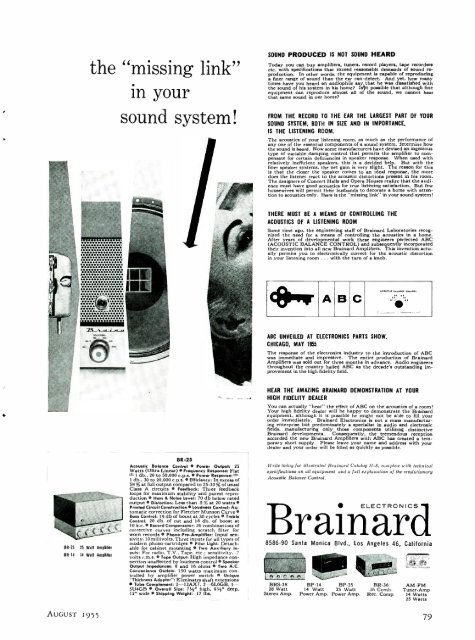Aug - AmericanRadioHistory.Com
Aug - AmericanRadioHistory.Com
Aug - AmericanRadioHistory.Com
Create successful ePaper yourself
Turn your PDF publications into a flip-book with our unique Google optimized e-Paper software.
the "missing link"<br />
in your<br />
sound system!<br />
SOUND PRODUCED IS NOT SOUND HEARD<br />
Today you can buy amplifiers, tuners, record players, tape recorders<br />
etc. with specifications that exceed reasonable demands of sound reproduction.<br />
In other words, the equipment is capable of reproducing<br />
a finer range of sound than the ear can -detect. And yet, how many<br />
times have you heard an audiophile say that he was dissatisfied with<br />
the sound of his system in his home? Islit possible that although fine<br />
equipment can reproduce almost all of the sound, we cannot hear<br />
that same sound in our home?<br />
FROM THE RECORD TO THE EAR<br />
THE LARGEST PART OF YOUR<br />
SOUND SYSTEM, BOTH IN SIZE AND IN IMPORTANCE,<br />
IS THE LISTENING ROOM.<br />
The acoustics of your listening room, as much as the performance of<br />
any one of the essential components of a sound system. determine how<br />
the sound is heard. Now some manufacturers have devised an ingenious<br />
type of variable damping control that permits the amplifier to compensate<br />
for certain deficiencies in speaker response. When used with<br />
relatively inefficient speakers, this is a decided help. But with the<br />
finer speaker systems, the net gain is very slight. The reason for this<br />
is that the closer the speaker comes to an ideal response, the more<br />
does the listener react to the acoustic distortions present in his room.<br />
The designers of Concert Halls and Opera Houses realize that the audience<br />
must have good acoustics for true listening satisfaction. But few<br />
housewives will permit their husbands to decorate home with attention<br />
to acoustics only. There is the "missing link" in your sound system!<br />
THERE MUST BE A MEANS OF CONTROLLING THE<br />
ACOUSTICS OF A<br />
LISTENING ROOM<br />
Some time ago, the engineering staff of Brainard Laboratories recognized<br />
the need for a means of controlling the acoustics in a home.<br />
After years of developmental work these engineers perfected ABC<br />
(ACOUSTIC BALANCE CONTROL) and subsequently incorporated<br />
their invention into all new Brainard Amplifiers. This invention actually<br />
permits you to electronically correct for the acoustic distortion<br />
in your listening room ... with the turn of a knob.<br />
cOlogr A B C<br />
ABC UNVEILED AT ELECTRONICS PARTS SHOW,<br />
CHICAGO, MAY 1955<br />
The response of the electronics industry to the introduction of ABC<br />
was immediate and impressive. The entire production of Brainard<br />
Amplifiers was sold out for three months in advance. Audio engineers<br />
throughout the country hailed ABC as the decade's outstanding improvement<br />
in the high fidelity field.<br />
BR-25 25 Wall Amplifier<br />
BR 14 14 Walt Ampliliet<br />
BR -25<br />
Acoustic Balance Control Power Output: 25<br />
Watts (Ultra Linear) Frequency Response: Flat<br />
1 db., 20 to 50.000 c.p.s. Power Response:<br />
1 db., 30 to 20,000 c.p.s. Efficiency: In excess of<br />
58 % at full output compared to 25 -30 % of usual<br />
Class A circuits Feedback: Three feedback<br />
loops for maximum stability and purest reproduction<br />
Hum i Noise Level: 70 db below rated<br />
output Distortion: Less than .5 % at 20 watts<br />
Printed Circuit Construction Loudness Control: Automatic<br />
correction for Fletcher Munson Curve<br />
Boss Control: 19 db of boost at 30 cycles Treble<br />
Control: 20 db. of cut and 18 db of boost at<br />
10 k.c. Record <strong>Com</strong>pensator: 36 combinations of<br />
corrective curves including scratch filter for<br />
worn records Phono -Pre- Amplifier: Input sen -<br />
sivity, 10 millivolts. Three inputs for all types of<br />
modern phono -cartridges Pilot Light: Detachable<br />
for cabinet mounting Two Auxiliary Inputs:<br />
For radio, T.V., Tape, etc.; sensitivity. .7<br />
volts r.m.s. Tope Output: High impedance connection<br />
unaffected by loudness control Speaker<br />
Output Impedances: 8 and 16 ohms Two A.C.<br />
Convenience Outlets: 150 watts maximum controlled<br />
by amplifier power switch Unique<br />
"Thickness Adapter ": Eliminates shaft extensions<br />
Tube <strong>Com</strong>plement: 2- 12AX7, 2- 6L6GB, 1 --<br />
5U4GB Overall Size: 75¡" high. 9y§" deep,<br />
12" wide Shipping Weight: 17 lbs.<br />
HEAR THE AMAZING BRAINARD DEMONSTRATION AT YOUR<br />
HIGH FIDELITY DEALER<br />
You can actually "hear" the effect of ABC on the acoustics of a room!<br />
Your high fidelity dealer will be happy to demonstrate the Brainard<br />
equipment. although it is possible he might not be able to fill your<br />
order immediately. Brainard Electronics is not a mass manufacturing<br />
enterprise but predominately specialist in audio and electronic<br />
fields, manufacturing only those components utilizing distinctive<br />
Brainard developments. Consequently, the tremendous reception<br />
accorded the new Brainard Amplifiers with ABC has created a temporary<br />
short supply. Please leave your name and address with your<br />
dealer and your order will be filled as quickly as possible.<br />
Write today for illustrated Brainard Catalog 11-8, complete with technical<br />
specifications on all equipment and a full explanation of the revolutionary<br />
Acoustic Balance Control.<br />
ramar<br />
ELECTRONICS<br />
8586 -90 Santa Monica Blvd., Los Angeles 46, California<br />
ft)<br />
^^^r<br />
BRS -28 BP -14 BP -25 BR -36 AM -FM<br />
28 Watt 14 Watt 25 Watt 36 <strong>Com</strong>b. Tuner -Amp<br />
Stereo Amp. Power Amp. Power Amp. Rec. <strong>Com</strong>p. 14 Watts<br />
25 Watts<br />
AUGUST 1955<br />
79
















